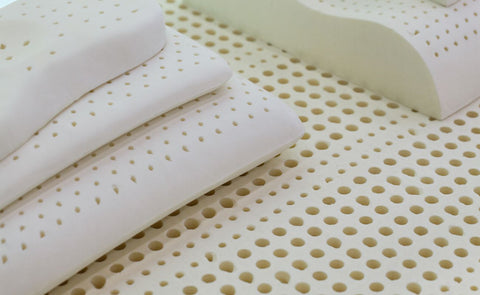When you slip into bed, your pillow is the unsung hero cradling your head, aligning your spine, and determining whether you wake refreshed or cranky. Latex vs. Memory Foam: The Great Pillow Debate isn’t just academic—it’s the difference between tossing all night and drifting off within minutes. By the end, you’ll know exactly which side of the debate will transform your nights.
Understanding the Rival Materials
What Is Latex?
Latex pillows are molded or shredded from either natural rubber tree sap, synthetic rubber, or a blend of the two. Natural latex offers quick spring‐back, excellent ventilation, and an eco-friendlier footprint.
What Is Memory Foam?
Memory foam is entirely synthetic, created from visco-elastic polyurethane. It softens with body heat, hugging every contour before slowly rebounding—great for pressure relief but notorious for trapping warmth.
Feel & Firmness: The Immediate Impression
-
Latex feels buoyant and springy. When you press down, it pushes back instantly.
-
Memory Foam feels slow and melting. Your hand sinks, leaving a temporary crater that gradually vanishes.
Why it matters for you: If you love a “floating” sensation, latex wins. Crave a deep, contouring hug? Memory foam has your back—literally.
Support & Spinal Alignment
Both materials cradle your cervical spine, yet they do so differently:
|
Sleep Position |
Latex Advantage |
Memory Foam Advantage |
|
Side |
Maintains loft without bottoming out, helpful for broad shoulders |
Conforms closely to relieve shoulder pressure |
|
Back |
Fast rebound keeps head level as you shift |
Deep cradle discourages chin-to-chest tilt |
|
Stomach |
Shredded or low-loft latex lowers neck strain |
Low-profile memory foam molds thin but may still feel dense |
Takeaway: Match loft to your position first, material second.
Temperature Regulation
Latex naturally contains microscopic pinholes and an open-cell structure that allows air to flow up to seven times better than dense memory foam, helping you stay cool through the night. Memory foam’s closed-cell design traps heat, though gel infusions and perforations can help—but rarely match latex’s natural breathability.
Durability & Longevity
-
Latex: Resists sagging for five to ten years, sometimes longer if it’s natural and cared for properly. The springiness you feel on night one is likely still there several anniversaries later.
-
Memory Foam: Quality varies widely. High-density foams may last five years, but lower densities can flatten in two or three, especially under heavier sleepers.
Allergy & Health Considerations
You may have heard natural latex is hypoallergenic. That’s largely true—the material resists dust mites and mold. Synthetic latex or blends can emit a rubbery odor early on, while memory foam may off-gas VOCs during its first few days. Letting any new pillow air out in a ventilated room mitigates smells quickly.
Price & Value
Natural latex pillows often sit at the premium end of the spectrum, while synthetic blends lower the cost. Memory foam ranges from budget cubes under $30 to luxury contour models north of $150. Decide what a pain-free neck is worth to you—then compare warranties and trial periods.
Quick-Reference Comparison
-
Responsiveness: Latex (fast) > Memory Foam (slow)
-
Pressure Relief: Memory Foam (deep contour) > Latex (gentle cradle)
-
Cooling: Latex (excellent) > Memory Foam (fair to good with cooling tech)
-
Eco-Friendliness: Natural Latex > Memory Foam
-
Price Flexibility: Memory Foam > Latex
-
Lifespan: Latex (long) > High-Density Memory Foam (moderate)
Choose Based on Your Sleep Style
Side Sleepers
You need loft and firmness that fill the space between shoulder and ear. A shredded latex blend lets you tweak height, while a thick memory foam wedge eases shoulder pressure. Try ~4 inches of loft as a starting point.
Back Sleepers
Aim for mid-loft (3–4 inches) to keep head and neck neutral. Latex rebounds as you reposition; memory foam keeps you steady if you don’t toss and turn.
Stomach Sleepers
The goal is the flattest pillow possible to prevent neck extension. Pick low-loft latex or a slim, ventilated memory foam pad. Some stomach sleepers ditch pillows altogether—listen to your body.
Care & Maintenance Tips
-
Use a breathable pillow protector to reduce sweat and oils.
-
Fluff or shake latex weekly to maintain loft.
-
Rotate memory foam monthly to distribute wear.
-
Spot-clean only—neither core belongs in the washer.
-
Replace when you notice dips greater than ½ inch or wake with neck pain.
Your Winning Pillow Pick
Now that you’ve weighed latex vs. memory foam, the path to better sleep is clear: prioritize the feel you crave, the temperature you need, and the longevity your budget allows. Whichever pillow you bring home, pair it with proper loft for your sleep position and a quality pillowcase. Make that choice tonight, and wake up to brighter mornings tomorrow.



